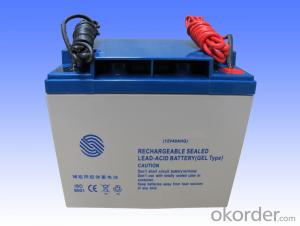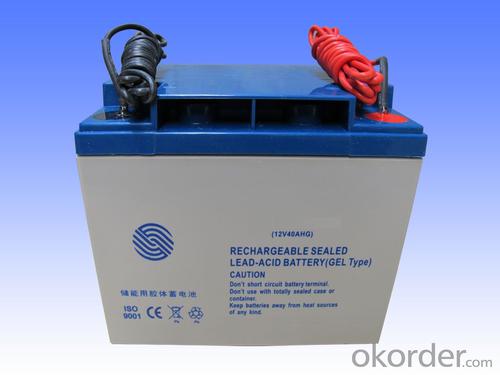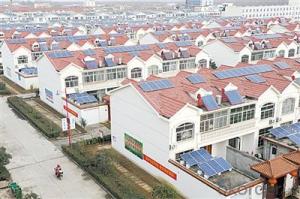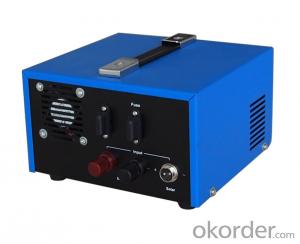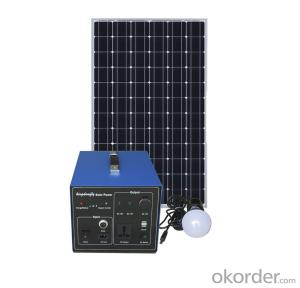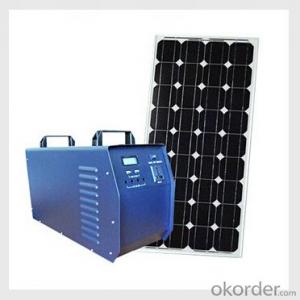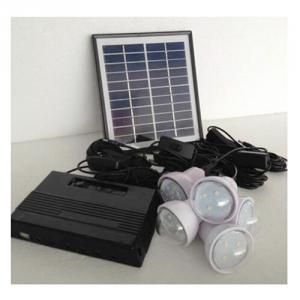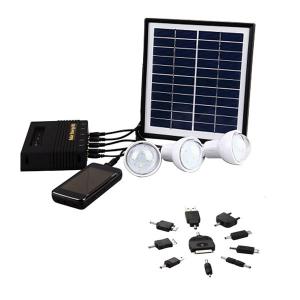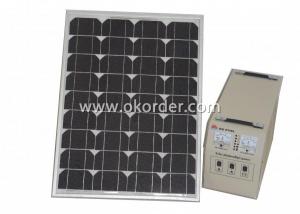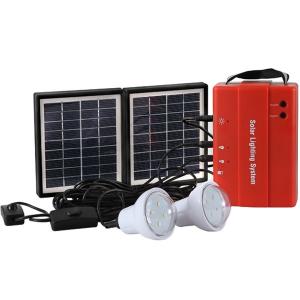Solar Energy Systems NSW Gel Storage Battery for Solar and Wind System
- Loading Port:
- China Main Port
- Payment Terms:
- TT or LC
- Min Order Qty:
- -
- Supply Capability:
- -
OKorder Service Pledge
OKorder Financial Service
You Might Also Like
What is the product?
· Precision explosion relief valve shall be adopted
· Advanced wrapping technology and assembly technology
· Designed life is fifteen years,excellent performance of battery in low temperature and superiority in consistence and stability
· Can be used at vertical or horizontal orientation
· Balanced design for both floating and cyclic operation
· Low self-discharge rate and long shelf life
· Connecting terminal adopts stainless steel bolt,thus it has the characteristics of high strength and non-deforming
· Design with patented corrosion resisting alloy and thickened plate
Gel Storage Battery (For Solar And Wind System) features:
1 Adopt suitable anode alloy formula, so that the battery is more suitable for the use of depth charge discharge cycle.
2 Colloidal electrolyte design, effectively inhibit AGM valve control lead-acid battery can not avoid electrolyte stratification phenomenon, and can better inhibit active substance loss and plate sulfation phenomenon, thus delaying the battery in the use of process performance decline, and improve the battery charge discharge cycle life.
3 Self discharge, Gel Storage Battery For Solar And Wind System has a longer service life, reduce the frequency and workload during storage battery maintenance.
4 Low floating charge voltage, charge current, battery charging efficiency is high; a good charge acceptance, less charge recovery ability.
Production facility, strict consistency of process requirements, to narrow the differences between individual battery; battery capacity, open circuit voltage and self discharge parameters matching, more consistent the battery pack in the individual characteristic curve, the overall performance is more excellent.
The battery electrolyte, - oxygen cycle is better than ordinary low water loss, prolong the service life of the battery.
5 Gel electrolyte way design and embedded copper core pole combined the battery safety further improved, the possibility of electrolyte leakage decreased further.
6 Gel Storage Battery For Solar And Wind System electrolyte using containing silica colloidal substances, is in gel state, does not flow; colloid injection for dilute sol state, good hydrophilicity, uniform dispersion, full of all the spaces inside the cell. Battery under high-temperature and overcharge conditions, resistant to over charging capability is strong, not easy to appear the phenomenon of dry, the gel battery has large heat capacity, heat dissipation is good, not easy to produce thermal runaway phenomenon. The battery can work in a more hostile environment.
It unique alloy and active material formulation, low-temperature discharge performance of battery greatly strengthened, and at the same time, the high performance of gelled electrolyte, the battery under the condition of low temperature charge acceptance ability improve, so as to ensure the battery excellent low-temperature discharge performance.
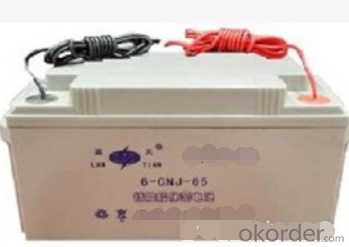
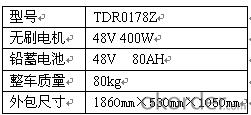
FAQ:
What's Application range?
*solar and wind power generation system
* communication systems: switches, microwave stations, mobile base stations, data centers, radio and radio station.
* the power plant and power transmission system;* signal system and emergency lighting system
What's the special advantage comparing with normal storage battery?
*The storage battery, with green environmental protection, long service life, self discharge, low internal resistance, good safety performance, characteristics of a wide range of temperature and so on, once for Xinjiang, Tibet, Qinghai and other light engineering support, Armed Police Frontier Corps provides large amount of photovoltaic system and power supply facilities, the existing product sales throughout the country, some products are also exported to Europe and the United States, to its quality and cheap access to the users.
How do you pack your products?
*We have rich experience on how to pack the panels to make sure the safety on shipment when it arrives at the destination.
- Q: Can solar energy systems be used for powering wastewater treatment plants?
- Yes, solar energy systems can definitely be used for powering wastewater treatment plants. Solar energy systems, such as solar panels, can be installed on the roofs or in open areas surrounding the treatment plants to generate electricity. This electricity can then be used to power the various components and processes involved in wastewater treatment, such as pumps, motors, blowers, and filtration systems. The use of solar energy for wastewater treatment plants offers several advantages. Firstly, it is a clean and renewable source of energy, which helps in reducing the carbon footprint and environmental impact of these facilities. Solar energy systems produce electricity without emitting any greenhouse gases or air pollutants, making them an environmentally friendly choice. Secondly, solar energy systems can provide a reliable and consistent power supply to the treatment plants. The availability of sunlight is generally predictable, and advancements in solar technology have made it possible to store excess energy in batteries for use during cloudy days or at night. This ensures uninterrupted operation of the wastewater treatment plants, even in areas with unreliable grid connections or frequent power outages. Furthermore, solar energy systems can also help in reducing operational costs for wastewater treatment plants. By generating their own electricity, these facilities can potentially decrease their dependence on the grid, leading to significant savings on energy bills. Additionally, solar energy systems require minimal maintenance and have a long lifespan, resulting in further cost savings over the years. In conclusion, solar energy systems can be effectively utilized for powering wastewater treatment plants. They offer a clean, reliable, and cost-effective solution that not only reduces the environmental impact but also provides energy independence to these critical facilities.
- Q: How do solar energy systems impact energy storage technologies?
- Solar energy systems have a significant impact on energy storage technologies by providing a clean and renewable source of electricity. These systems generate electricity during the day when the sun is shining, but often produce more energy than needed. Energy storage technologies allow excess energy to be stored and used during periods of low or no solar generation, ensuring a constant and reliable power supply. This integration of solar energy systems with energy storage technologies promotes grid stability, reduces reliance on fossil fuels, and accelerates the transition towards a sustainable energy future.
- Q: Do solar energy systems require grounding?
- Yes, solar energy systems do require grounding for several reasons. Firstly, grounding helps to protect the system and its components from electrical faults, lightning strikes, and power surges by providing a safe path for excess electrical energy to dissipate into the ground. Additionally, grounding helps to minimize the risk of electric shock for individuals who may come into contact with the system. Overall, proper grounding is essential for the safe and efficient operation of solar energy systems.
- Q: Can solar energy systems be used for powering boats?
- Yes, solar energy systems can be used to power boats. Solar panels can be installed on the boat to capture sunlight and convert it into electrical energy, which can then be used to power various systems onboard, including propulsion, lighting, and navigation equipment. This renewable energy source is increasingly being adopted by boat owners as it reduces dependence on fossil fuels, lowers operating costs, and helps to minimize environmental impact.
- Q: Are there any insurance considerations for solar energy systems?
- Yes, there are several insurance considerations for solar energy systems. First and foremost, it is important to ensure that the solar energy system is adequately insured against damage or loss. This typically involves obtaining property insurance coverage that specifically includes the solar panels and related equipment. Additionally, liability insurance is also crucial for solar energy systems. This type of insurance protects against any damages or injuries that may occur as a result of the solar energy system, such as a panel falling and causing property damage or personal injury. Liability coverage should be sufficient to cover potential risks and liabilities associated with the installation, operation, and maintenance of the system. It is also important to consider business interruption insurance. This type of coverage can provide financial protection in the event that the solar energy system becomes damaged or malfunctions, resulting in a loss of power production and revenue. Business interruption insurance can help to cover the costs of repairs, replacement equipment, and any lost income during the downtime. Finally, it is advisable to consult with an insurance professional who specializes in renewable energy systems to ensure that all potential risks and exposures are properly covered. They can assist in identifying any additional insurance considerations specific to the solar energy system and provide guidance on the appropriate types and levels of coverage needed to adequately protect the investment.
- Q: Can solar energy systems be used in areas with high levels of noise pollution?
- Yes, solar energy systems can be used in areas with high levels of noise pollution. Solar panels do not produce any noise themselves, as they generate electricity by converting sunlight into energy. Therefore, noise pollution does not affect the performance or functionality of solar energy systems.
- Q: Can solar panels be installed on different surfaces like glass or metal?
- Yes, solar panels can be installed on different surfaces like glass or metal. In fact, solar panels are commonly installed on rooftops, which are often made of materials like glass, metal, or asphalt shingles. The most common type of solar panels, known as photovoltaic (PV) panels, are designed to be mounted on a variety of surfaces. The installation process involves securing the panels to the surface using racks or frames, ensuring that they are properly angled to maximize sunlight exposure. Whether it is a glass or metal surface, solar panels can be installed and effectively generate electricity from the sun's energy.
- Q: What is the environmental impact of using solar energy systems?
- Solar energy systems have a significantly lower environmental impact compared to traditional energy sources. The primary environmental benefits of using solar energy include reduced greenhouse gas emissions, minimized air and water pollution, conservation of natural resources, and decreased reliance on fossil fuels. Additionally, solar energy systems have a relatively low ecological footprint and are renewable, making them crucial for transitioning towards a more sustainable energy future.
- Q: Can solar energy systems be used for space exploration?
- Yes, solar energy systems can be used for space exploration. Solar panels are commonly used to power satellites and space probes, as they can efficiently convert sunlight into electricity in the vacuum of space. This renewable energy source helps to provide a reliable and sustainable power supply for various space missions, reducing the dependence on traditional fuel-based systems.
- Q: Can a solar energy system be used in areas with limited sunlight?
- Indeed, the utilization of a solar energy system remains feasible in regions with limited sunlight. Although solar panels are most effective when directly exposed to sunlight, they are still capable of generating power in areas with limited sunlight. Even on cloudy days or during periods of low sunlight, solar panels can still produce electricity, albeit with reduced efficiency. Furthermore, the advancement of solar panel technology enables panels to capture and convert even diffuse sunlight, enabling their functionality in areas with limited direct sunlight. Additionally, solar energy systems can be tailored to incorporate energy storage solutions such as batteries. This enables the storage of excess energy generated during peak sunlight hours for later use during periods of limited sunlight. Consequently, solar energy remains a viable and sustainable solution for various regions worldwide, even those with limited sunlight.
Send your message to us
Solar Energy Systems NSW Gel Storage Battery for Solar and Wind System
- Loading Port:
- China Main Port
- Payment Terms:
- TT or LC
- Min Order Qty:
- -
- Supply Capability:
- -
OKorder Service Pledge
OKorder Financial Service
Similar products
Hot products
Hot Searches
Related keywords
